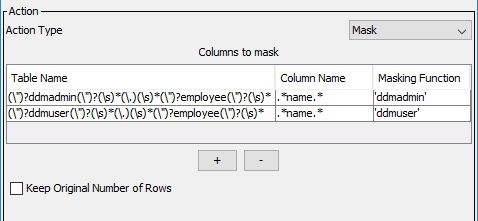Dynamic Data Masking
- Dynamic Data Masking 9.9.4
- All Products

If Database is...
| And Table Name Contains...
| Use this format for the Regular Expression
|
|---|---|---|
Oracle
| schemaName.tableName
| (\")?<SchemaName>(\")?(\s)*(\.)(\s)*(\")?<TableName>(\")?(\s)*
|
schemaName.tableName with DBlink
| (\")?<SchemaName>(\")?(\s)*(\.)(\s)*(\")?<TableName>(\")?(\s)*(\@)(\s)*(\")?<DBLink>(\")?(\s)*
| |
tableName with DBlink
| (\")?<TableName>(\")?(\s)*(\@)(\s)*(\")?<DBLink>(\")?(\s)*
| |
Microsoft SQL Server
| schemaName.tableName
| (\")?<SchemaName>(\")?(\s)*(\.)(\s)*(\")?<TableName>(\")?(\s)*
If the object in the user query is enclosed by square brackets as in [schemaName].[tablename], use the following format:
(\[)?<SchemaName>(\])?(\s)*(\.)(\s)*(\[)?<TableName>(\])?(\s)*
|
Database.schemaName.tableName
| (\")?< Database Name>(\")?(\s)*(\.) (\")?<SchemaName>(\")?(\s)*(\.)(\s)*(\")?<TableName>(\")?(\s)*
| |
LinkedServer.Database.schemaName.tableName
| (\")?< LinkedServer Name>(\")?(\s)*(\.) (\")?< Database Name>(\")?(\s)*(\.) (\")?<SchemaName>(\")?(\s)*(\.)(\s)*(\")?<TableName>(\")?(\s)*
| |
Teradata
| schemaName.tableName
| (\")?<SchemaName>(\")?(\s)*(\.)(\s)*(\")?<TableName>(\")?(\s)*
|
Hive
| schemaName.tableName
| (\")?<SchemaName>(\")?(\s)*(\.)(\s)*(\")?<TableName>(\")?(\s)*
If the object in the user query is enclosed by a back quote as in 'schemaName'.'tablename' use the following format:
(\`)?<SchemaName>(\`)?(\s)*(\.)(\s)*(\`)?<TableName>(\`)?(\s)*
|
select da.first_name,du.first_name from ddmadmin.employee da, ddmuser.employee du

select da.first_name,du.first_name from ddmadmin.employee da, employee du
